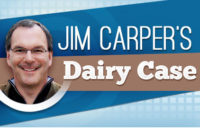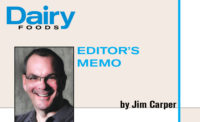
A Little Means A Lot
by Julie Cook Ramirez
Contributing Editor
Portion control gains momentum, but indulgence still reigns for ice cream.
Ice cream has never been considered a health food. However, it does possess many positive attributes. For starters, it’s a great source of calcium and protein. And many popular inclusions — nuts and chocolate, for example — have been shown to be beneficial to health.
That leaves many wondering whether ice cream has been
able to bridge the gap and take advantage of the “healthy halo”
that’s currently illuminating much of the dairy category.
Overall, ice cream remains a “decadent
delight,” according to Diane Austin, vice president of marketing,
Perry’s Ice Cream, Akron, N.Y. However, she is quick to point out
that some of the fastest-growing segments of the category involve so-called
“better-for-you” products, including reduced-fat, fat-free and
no-sugar-added offerings.
“Three-fourths of ice cream sales are still
full-fat, but the trend has been shifting as more and more consumers are
buying what the industry has come to call better-for-you products,”
says Adam Baumgartner, senior marketing manager for retail brand
development, Wells’ Dairy Inc., Le Mars, Iowa. “Manufacturers
are recognizing that opportunity and with new technology and formulations,
they have been given the ability to deliver great-tasting products that
have really helped bridge that gap for consumers.”
Indeed, the vast R&D initiatives of recent years
have resulted in a wealth of new products offering literally not just
something for everyone, but something for every occasion, and every
daypart. Manufacturers have come to recognize that’s not just a
matter of health-conscious consumers always wanting better-for-you products
and more decadent-minded consumers only wanting super-indulgent products.
Rather, the same consumer might want a super-premium full-fat ice cream on
one occasion and a lowfat or no-sugar-added product at another time.
“Consumers are looking at their diets as a
whole, and everything they eat plays a part in that,” Austin says.
“They don’t want to eliminate foods that they love; they just
want to be smarter about it.”
Thus, the rise of a new breed of portion-controlled
ice creams. Clinging to the mantra “everything in moderation,”
even the most health-conscious of consumers seeks to answer the desire to
indulge from time to time. Thanks to portion-controlled packages, they
don’t have to exclude ice cream from their diets entirely.
“Ice cream fills a unique void for consumers in
that it is so comforting, so satisfying, so personal, and special,”
Baumgartner says. “Portion-controlled ice cream gives them the
opportunity to have a premium packaged ice cream experience in just the
right size.”
In addition to providing consumers with a convenient
means of “self-policing,” Austin says portion-controlled ice
cream also makes it easier for them to enjoy indulgence on the run.
Wells’ Blue Bunny Personals line of
portion-controlled ice cream gives consumers the opportunity to indulge in
decadent flavors like Cappuccino Fudge Blitz, Peanut Butter Panic or Super
Chunky Cookie Dough without running the risk of downing an entire quart.
Meanwhile, Good Humor-Breyers Ice Cream Co., a division
of Unilever North American Ice Cream, recently unveiled Breyers Double
Churn 100 Calorie Cups. Sold in six-packs, these single-serving cups are
available in Cookies & Cream and Vanilla Fudge Swirl varieties. Last
year, the Green Bay, Wis.-based company introduced the Cyclone line of
soft-frozen ice cream with indulgences, like brownie or cookie pieces,
mixed in.
Convenience store packages of Cyclone are made to fit
car cup holders and contain a spoon under the lid for on-the-go indulgence.
| Top 10 Ice Cream/Sherbet Brands* | ||||
| $ Sales (In Millions) | % Change vs. Year Ago | Unit Sales (In Millions) | % Change vs. Year Ago | |
| Total Category | $4,403.0 | -0.3% | 1,370.0 | -0.4% |
| Private Label (Ice Cream) | 812.8 | -2.7 | 285.9 | -0.4 |
| Breyers | 638.8 | 7.5 | 196.7 | 10.0 |
| Dreyer’s/Edy’s Grand | 445.1 | -1.0 | 130.9 | -4.7 |
| Häagen-Dazs | 287.3 | 12.1 | 83.4 | 7.2 |
| Dreyer’s/Edy’s SlowChurned | 284.0 | 100.8 | 76.8 | 93.3 |
| Blue Bell | 253.2 | 2.0 | 75.0 | 1.0 |
| Ben & Jerry’s | 207.6 | 8.7 | 67.8 | 10.1 |
| Wells’ Blue Bunny | 122.0 | 14.0 | 34.6 | 17.1 |
| Turkey Hill | 116.9 | 13.8 | 41.8 | 14.1 |
| Private Label (Sherbet/Sorbet/Ices) | 59.8 | -4.0 | 27.3 | -2.7 |
| *Total sales of all forms of ice cream/sherbet brands in supermarkets, drug stores and mass merchandisers (excluding Wal-Mart) in the 52-week period ending December 31, 2006. SOURCE: Information Resources Inc. |
||||
Continuous Evolution
Consumers seeking better-for-you indulgence are also
increasingly returning to frozen yogurt, Baumgartner says. He believes
cup-yogurt consumers are looking to reap the same kinds of benefits from a
frozen product as they have from the refrigerated form.
Recognizing that fact, manufacturers are once again
dedicating some R&D money to ramping up their frozen yogurt offerings.
To that end, Nestle-owned Dreyer’s Grand Ice Cream Inc., Oakland,
Calif., has introduced Slow Churned Yogurt Blends in both its
Dreyer’s and Edy’s brands. Slow Churned Yogurt Blends is a line
of cultured frozen dairy desserts, promising improved taste and texture
thanks to Dreyer’s ultra-low temperature freezing process.
It contains live and active cultures, something that
the company actively promotes on-pack to help consumers make the connection
between refrigerated yogurt and frozen yogurt.
Baumgartner says Wells’ Dairy is “looking
at ways we can continue to innovate and differentiate in frozen
yogurt.” However, he is quick to point out that while frozen yogurt
is “a good supplement to have,” ice cream remains the name of
the game. Therefore, it will remain the company’s primary focus.
By all accounts, the ice cream category could use a
good kick in the pants. During the 52-week ending December 31, 2006, sales
of ice cream and sherbet dipped 0.3 percent in dollars and 0.4 percent in
units across supermarkets, drug stores and mass merchandisers, excluding
Wal-Mart, according to Chicago-based Information Resources Inc. (IRI).
While the category as a whole hasn’t exactly
given processors anything to write home about lately, several individual
brands have managed to rack up pretty impressive increases. Sales of
branded leader Breyer’s rose 7.5 percent in dollars and 10 percent
increase in units, while Haagen-Dazs sales increased 12.1 percent and 7.2
percent, respectively. Dreyer’s/Edy’s Slow Churned sales rose
100.8 percent and 93.3 percent, while Ben & Jerry’s sales were up
8.7 percent and 10.1 percent. Wells’ Blue Bunny sales rose 14.0 and
17.1 percent, while Turkey Hill sales were up 13.8 percent and 14.1
percent.
Meanwhile, private label managed to retain the top spot
with an 18.5 percent dollar share, but its sales losses outpaced those of
the overall category, down 2.7 percent in dollars and 0.4 in units.
According to Baumgartner, those figures demonstrate how
satisfied consumers are with branded ice cream.
“Consumers are extremely satisfied with what the
brands are delivering to them,” Baumgartner says. “They are
really resonating with what the brands have to offer — there’s
more flavors, more variety, more excitement and just overall comfort with
what the major brands are bringing to the table.”
And the table just keeps getting fuller. Burlington,
Vt..-based Ben & Jerry’s Homemade Inc., a division of Unilever
North American Ice Cream, recently introduced AmeriCone Dream, a
“decadent melting pot of vanilla ice cream with fudge-covered waffle
cone pieces and a caramel swirl.” The flavor features Comedy Central
star Stephen Colbert on the carton.
Meanwhile, Minneapolis-based Kemps LLC has set out to
give Paducah, Ky.-based Dippin Dots Inc. a run for its money, rolling out
IttiBitz, a “revolutionary new chilled dessert product concocted of
small creamy bits of ice cream.” Kemps, owned by HP Hood LLC, claims
IttiBitz is different from other pelletized products because its ice cream
balls are larger in size, boast an eight-month shelf-life and can be
served, stored and shipped just like regular ice cream at temperatures of
up to 10 degrees. Currently, Ittibitz are available in Banana Split,
Cookies & Cream, Mint Chip, Cotton Candy, Strawberry, Vanilla and
Neapolitan varieties.
“The category’s continuing to change and
evolve, and you can’t sit on last year’s innovations,”
Austin says. “You’ve got to reinvent yourself and find new ways
to bring consumers to the brand. If you do that, they will buy.”
Julie Cook Ramirez is a freelance journalist based in
the Chicago area.
$OMN_arttitle="A Little Means A Lot";?>
$OMN_artauthor="Julie Cook Ramirez";?>
